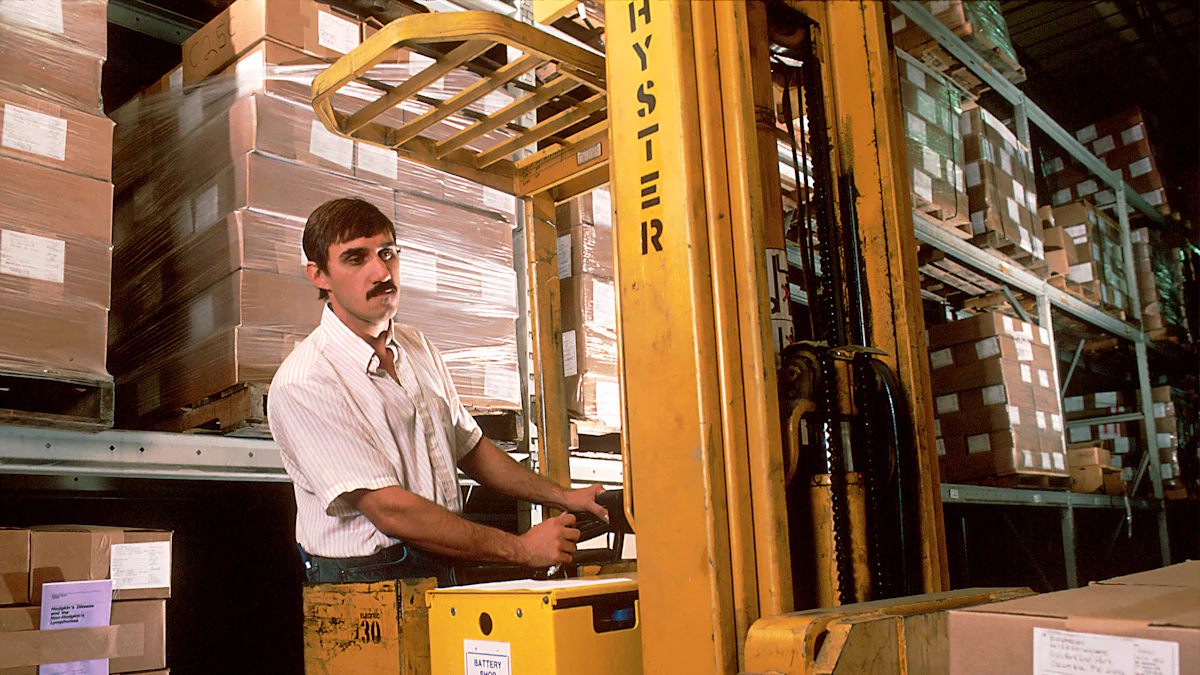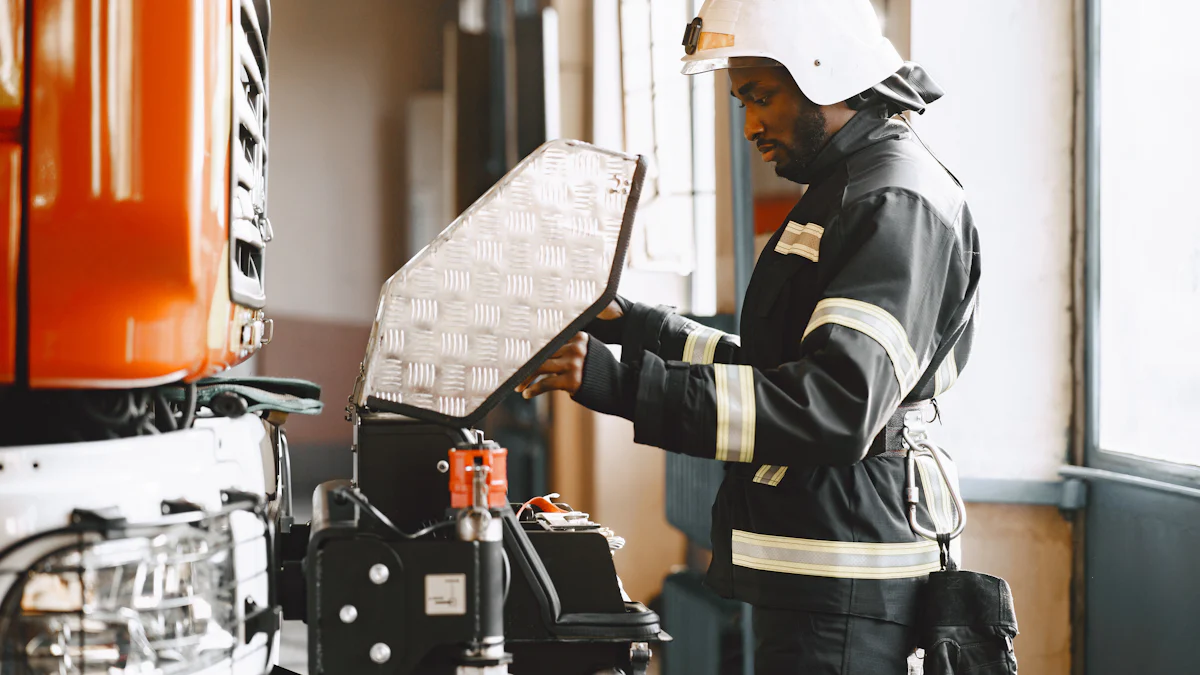
When considering the operational efficiency of semi self load stackers, it becomes evident that their role in industrial environments is paramount. The seamless utilization of these machines can significantly impact productivity and safety measures within a facility. This blog aims to equip readers with practical insights and strategies to maximize the benefits of self load stackers effectively.
Understanding Semi Self Load Stackers
When delving into the realm of semi self load stackers, it is crucial to grasp their essence and functionalities. These machines, designed for efficient material handling, play a pivotal role in industrial operations.
What are Semi Self Load Stackers?
Definition and key features
To comprehend the nature of semi self load stackers, one must acknowledge their core attributes. Semi-electric stackers are equipped with essential features that ensure stability and safety during lifting tasks. The weights on the stacker should be stable, maintaining the center of gravity within the forks’ center. It is imperative to adhere to the lifting load weight parameters indicated on the label to prevent any mishaps.
Types and variations
Within the realm of material handling equipment, pallet stackers stand out as versatile tools for transporting goods efficiently. Safety remains a top priority in any workplace, and pallet stackers contribute significantly to this aspect. Equipped with safety mechanisms such as brakes and ergonomic handles, pallet stackers mitigate risks associated with manual lifting practices.
Benefits of Using Semi Self Load Stackers
Increased productivity
The utilization of self load stackers can lead to a substantial boost in productivity within industrial settings. By streamlining material handling processes, these machines facilitate swift and efficient movement of goods across various workstations.
Enhanced safety
Safety considerations are paramount in any operational environment, and semi self load stackers excel in ensuring a secure working atmosphere. With features like load retention systems and stable lifting capacities, these stackers minimize the risk of accidents or injuries during material handling tasks.
Cost-effectiveness
Incorporating semi self load stackers into daily operations not only enhances efficiency but also proves to be cost-effective in the long run. By optimizing workflow processes and reducing manual labor requirements, these machines contribute to overall cost savings for businesses.
Pre-Operational Checks

Inspecting the Equipment
Visual inspection
- Examine the stacker for any visible damages or irregularities that may affect its performance.
- Check for signs of leaks, loose components, or worn-out parts that require immediate attention.
- Ensure all safety features are intact and functional to guarantee a secure operational environment.
Checking for wear and tear
- Assess the condition of the forks, wheels, and hydraulic systems to identify any signs of wear.
- Look for cracks, rust, or deformation in critical areas that could compromise the stacker’s structural integrity.
- Verify that all moving parts operate smoothly without unusual noises or resistance.
Ensuring Proper Functionality
Testing controls and mechanisms
- Test each control function systematically to confirm proper responsiveness and accuracy.
- Check the steering, lifting, and lowering mechanisms to ensure they function smoothly without delays.
- Validate emergency stop functionalities to guarantee immediate halting in case of unforeseen circumstances.
Verifying load capacity
- Refer to the manufacturer’s guidelines to determine the maximum load capacity of the stacker.
- Conduct load tests with varying weights to verify that the stacker can lift and transport loads safely.
- Avoid exceeding the specified weight limits to prevent overloading and potential accidents during operations.
By meticulously conducting pre-operational checks on semi self load stackers, operators can proactively address maintenance issues, mitigate risks, and uphold operational efficiency in industrial settings. Remember, safety is paramount in every step of material handling processes!
Best Practices for Operation
Loading and Unloading
Correct positioning of loads
When initiating the loading or unloading process with a semi self load stacker, operators must prioritize the correct positioning of loads. Placing the loads at the designated location on the forks ensures optimal stability and balance during transportation.
Balancing the load
Achieving a balanced load distribution is essential for safe and efficient operation. By evenly distributing the weight across the forks, operators can prevent tilting or instability issues while maneuvering the self load stacker within the facility.
Maintaining the load center of cargo
Ensuring that the center of gravity of the cargo remains aligned with the stacker’s forks is crucial for maintaining control and stability. Operators should consistently monitor and adjust the position of the load to prevent any potential hazards during transportation.
Maneuvering the Stacker
Safe driving techniques
Implementing safe driving techniques is paramount when operating a semi self load stacker in industrial settings. Operators should adhere to designated speed limits, avoid sudden movements, and maintain a clear line of sight to prevent accidents or collisions.
Navigating tight spaces
In scenarios where space is limited, operators must exercise caution and precision when navigating with a self load stacker. Utilizing gradual maneuvers, observing surroundings, and communicating effectively with colleagues can help mitigate risks associated with confined work areas.
Watching the top height
Monitoring the top height clearance is vital to prevent collisions with overhead obstacles or structures. Operators should be vigilant about vertical clearances, especially when stacking or transporting goods in elevated areas using a semi self load stacker.
Maintenance and Care
Regular cleaning and lubrication
Routine maintenance practices such as cleaning debris accumulation and applying lubricants to moving parts are essential for preserving the longevity and performance of self load stackers. By keeping components clean and well-lubricated, operators can enhance operational efficiency.
Scheduled maintenance checks
Conducting regular inspections and maintenance checks on critical components like brakes, hydraulics, and electrical systems is imperative for ensuring optimal functionality. Following manufacturer guidelines for scheduled maintenance helps identify potential issues early on.
Reviewing the instruction handbook
Referencing the instruction handbook provided by electric stacker manufacturers offers valuable insights into operational guidelines, safety precautions, and troubleshooting procedures. Familiarizing oneself with this resource enhances operator proficiency and contributes to overall safety compliance.
Safety Guidelines

Operator Training
Importance of proper training
- Adequate training for operators of semi self load stackers is essential to ensure safe and efficient operations within industrial environments.
- Properly trained operators possess the necessary skills to handle the equipment effectively, reducing the risk of accidents and enhancing overall productivity.
- Training programs focus on operational techniques, safety protocols, and emergency procedures to equip operators with comprehensive knowledge for optimal performance.
Training programs and certifications
- Certified training programs provide theoretical knowledge and practical experience to operators, emphasizing the importance of safety measures and operational best practices.
- Completion of training courses ensures that operators are proficient in handling self load stackers competently, contributing to a secure working environment and preventing potential hazards.
- Obtaining certifications validates an operator’s expertise in operating semi self load stackers, demonstrating compliance with industry standards and regulations.
Workplace Safety Measures
Clear pathways and designated areas
- Maintaining clear pathways and designated areas for self load stacker operations is crucial to prevent obstructions, reduce the risk of collisions, and ensure smooth workflow processes.
- Clearly marked zones help guide operators during material handling tasks, promoting efficiency while minimizing disruptions in daily operations.
- By establishing specific routes for semi self load stackers, workplaces can enhance safety measures, optimize traffic flow, and mitigate the likelihood of accidents or incidents.
Use of personal protective equipment (PPE)
- Personal protective equipment (PPE) such as helmets, gloves, safety shoes, and high-visibility vests are essential gear for operators working with self load stackers in industrial settings.
- PPE safeguards operators from potential hazards like falling objects, sharp materials, or slippery surfaces, ensuring their well-being during operational activities.
- Adhering to PPE guidelines not only protects individuals but also promotes a culture of safety consciousness within the workplace environment.
Blocking bottom tiers of drums, barrels, and kegs
- Blocking the bottom tiers of drums, barrels, and kegs when storing them on their sides is a critical safety measure to prevent rolling hazards in warehouses or storage facilities.
- Securing the lower sections of cylindrical containers minimizes the risk of accidental movement or displacement during stacking or transportation processes with semi self load stackers.
- Implementing this preventive measure enhances workplace safety by reducing the potential for injuries caused by unstable loads or shifting containers.
Recapping the essential guidelines for optimal semi self load stackers operation reinforces workplace efficiency and safety. Emphasizing the advantages of using these machines correctly highlights their significant impact on productivity and risk mitigation. Encouraging the implementation of these practical tips ensures a seamless integration of best practices, leading to improved performance and operational excellence. Remember, adherence to proper procedures is key to unlocking the full potential of self load stackers in industrial environments.
Post time: Jun-25-2024
